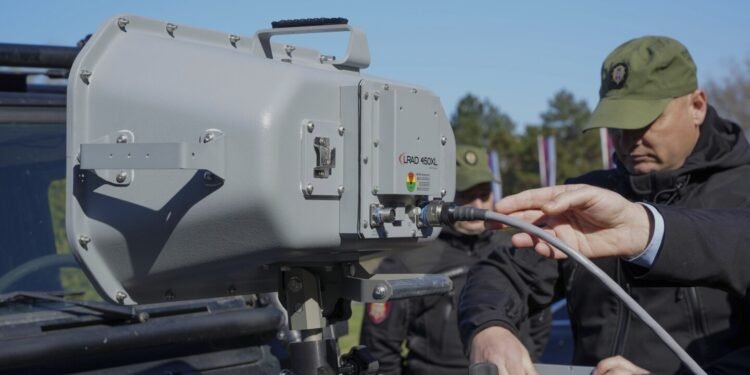BELGRADE, Serbia (news agencies) — Ivana Ilic Sunderic had never heard anything quite so alarming and disturbing at a protest as the sound that broke a commemorative silence during a huge anti-government rally in Serbia’s capital, Belgrade.
“It was quiet and peaceful and then we heard something we could not see … like a sound rolling toward us, a whiz,” Ilic Sunderic said about the March 15 incident. “People started rushing for safety toward the pavement, feeling that something was moving toward us down the street.”
It was “a subdued sound lasting only 2-3 seconds but very unusual and very frightening, like a sound from hell,” she said.
Ilic Sunderic was not alone in describing the panic. Hundreds of others have offered similar accounts, triggering accusations that the police, military or security services under the tight control of authoritarian Serbian President Aleksandar Vucic used an acoustic crowd control weapon to target peaceful protesters.
The weapons, which are illegal in Serbia, emit sound waves which can trigger sharp ear pain, disorientation, eardrum ruptures or even irreversible hearing damage.
The incident piled more pressure on Vucic, who has been rattled by nearly five months of anti-corruption protests over the collapse in November of a concrete canopy at a railway station in the northern town of Novi Sad that killed 16 people.
Serbia’s officials have issued often contradictory denials that an acoustic weapon was directed at the demonstrators. Calls have been mounting for answers as to what caused the sudden commotion, if not a sonic device.
An media video shows thousands of protesters holding up their lit mobile phones in silence when they suddenly start running away in panic. A swooshing sound can then be heard.
“I have been going to protests for 30 years but I’ve never heard anything like this,” Ilic Sunderic said.
A defiant Vucic has rejected what he called “lies and fabrications” that the security services targeted the demonstrators with a sonic device. He said that such accusations are part of an alleged Western-orchestrated ploy to topple him.
“If there was a single piece of evidence that a sound cannon was used against demonstrators, then I would no longer be president,” he said.
Serbia’s police, army and the state security agency, BIA, initially all denied possessing the U.S.-made Long Range Acoustic Device (LRAD), which is illegal in Serbia and some other countries. When presented with photos of the device mounted on an off-road vehicle and deployed at the rally of hundreds of thousands of protesters, officials admitted possessing a sonic weapon, but insisted it was not used against the protesters.
The photos showed nothing more than “loudspeakers” that also are available on eBay, Interior Minister Ivica Dacic said. The rectangular devices, purchased from a U.S. supplier in 2021, serve to emit warnings to the crowds in case of major trouble, he said.
“Serbian police have never, including March 15, used any illegal or unallowed device that is not envisaged by the law, including the device known as a sound cannon,” Dacic said. “Police only use sound devices for warnings.”
Sonic weapons use sound waves to incapacitate, disorient or harm individuals by harnessing acoustic energy, causing both physical and psychological effects, such as dizziness, disorientation or severe headaches.
Although often described as non-lethal, their use in military, law enforcement and covert operations has raised serious ethical concerns.
More recently, sonic devices have been used against Somali pirates as well as migrants in Greece and reportedly in Serbia.
Images from the Belgrade protest show what appears to be an LRAD 450XL.
The California-based manufacturer, Genasys, said on X that “the video and audio evidence we have seen and heard thus far does not support the use of an LRAD during the March 15th incident in Belgrade, Serbia.”
Many who were in the crowd later complained of headaches, confusion, ear pressure or nausea.









 United Arab Emirates Dirham Exchange Rate
United Arab Emirates Dirham Exchange Rate

